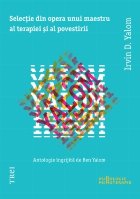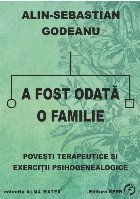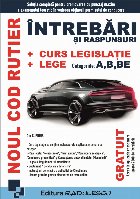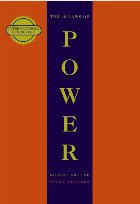
Disponibilitate: nedisponibila
Preț: 44,00 LEI
ISBN: 9786064003171
Autor(i): Simona Reghintovschi
Editura: Trei
Anul apariției: 2017
Nr. pagini: 240 pagini
Categorii: Psihologie, Carte nefolosită, Psihoterapie
In recent years, psychologists and anthropologists integrate in their research designs psychoanalytically informed methods in order to address the unconscious forces and motivations that provide a deeper understanding of individual experience and a better image of the research environment. Also, psychoanalysts used their psychoanalytic knowledge to design a specific methodology for the study of unconscious phenomena outside the clinical setting. The Psychoanalytic ‘Laboratory’ offers a new perspective on psychoanalytically informed researched interview as an experimental situation, that offers the possibility to test psychoanalytic theories, not only to illustrate them.
Simona Reghintovschi has a PhD in psychoanalytic studies from University of Essex, Great Britain. She teaches Projective Methods and Applied Psychoanalysis at Titu Maiorescu University in Bucharest. She is psychoanalyst, full member of Romanian Society of Psychoanalysis, and co-founder of Insight Association dedicated to the advancement of psychoanalysis.
Cuprins
Foreword
Introduction
Part I . The psychoanalytic ‘laboratory’
Chapter 1. From Anxiety to Method in Social Sciences Research
1.1. Searching for a scientific method in the social sciences
1.2. Dealing with anxiety — neutrality or complementarity?
1.3. Levels of countertransference
1.3.1. Individual level — countertransference as observer’s transference
1.3.2. Social level — Elicited countertransference as ‘complementary role’
1.4. Complementary role as receiver’s side of projective identification
1.4.1. The projector’s side — The Sedang head-hunters and their Shamans
1.4.2. The receiving end of the projection — the observer
1.4.3. Projective identification and the social container
Chapter 2. Psychoanalytically informed research interview
2.1. Quantitative vs. Qualitative method in the study of
2.2. Qualitative research interview
2.3. Psychoanalytically informed research interview
2.3.1. What is to be noticed and why?
2.4. Main features of psychoanalytically informed interview
2.4.1. Free associations
2.4.2 Transference and Countertransference in the Interview Relationship
2.4.3 How can we interpret what we notice?
2.4.4. How can we know that our interpretation is the ‘right’ one?
2.4.5. Analysis of the psychoanalytically informe dresearch interview
2.5. Limitations
Chapter 3. Using psychoanalytically informed interview as an experimental situation
3.1. The psychoanalytic session as an experimental situation
3.2. Psychoanalytically informed interview as an experimental situation
Part II. Inside the lab
Chapter 4. Conflict and Schism in the Psychoanalytic Institutions
4.1. The psychoanalytic ‘family’
4.1.1. The ‘good’ family — hatred held in check
4.1.2. The ‘bad’ family — The ‘primal horde’ in psychoanalytic institutes
4.1.3. The complex family — Lethal sibling jealousy
4.2. Emotional ‘radioactivity’ in psychoanalytic institutes
4.3. Psychoanalytic institution as ‘secret society’
4.4. The dynamics of political power 7
4.5. Narcissism of minor differences in the psychoanalytic establishment
4.6. Freud as a leader and organizational culture
4.7. Conflicts and schism as institutional symptom
Chapter 5. The research design
5.1. The setting
5.2. The logic
5.3. Discussion
Appendix. The ‘Story’ of Countertransference
1. Countertransference as analyst’s neurotic reaction
1.1. Freud’s recommendations on psychoanalytical technique
1.2. Analyst’s feelings as neurotic symptom
2. Countertransference as an expression of ‘being human’
2.1. Ferenczi against the myth of "impersonal analyst"
2.2. Michael Balint — the ‘correct method’ versus analyst’s personal technique/tension at an optimal level
3. Countertransference as danger and instrument
Heinrich Racker — countertransference as a danger and a guide in understanding the patient
4. Countertransference as ‘objective’ feelings
4.1. D. W. Winnicott: ‘objective’ feelings of the analyst
4.2. Margaret Little’s response to Winnicott — The hall of subjective mirrors
5. Countertransference as creation of the patient
5.1. Paula Heimann: neuter, neutral or natural analyst
5.2. Betty Joseph — countertransference as a guide in the transference
6. Countertransference as containment
6.1. Roger Money-Kyrle — Finding a reference point
6.2. Bion and containment
References
Comandă online The Psychoanalytic ‘Laboratory’ la 44,00 lei isbn 9786064003171 scrisă de Simona Reghintovschi, tiparită la editura Trei în anul 2017. cu plata ramburs sau online cu cardul. Momentan titlul The Psychoanalytic ‘Laboratory’ nu este disponibil însa vă puteți înscrie pentru a fi notificat în momenul reaprovizionarii.

Selecţie din opera unui maestru al terapiei şi al povestirii
Trei
Irvin D. Yalom
9789737077066
392 pagini
An: 2013

Trainingul deprinderilor DBT. Manual
Romanian Psychological Testing Services
Marsha M. Linehan, Bora Carmen Hortensia, Chereji Simona Veronica, Catalin Lulea
9789731816562
474 pagini
An: 2022

Tată absent, fiu ratat : Ce au devenit bărbaţii?
Philobia
Guy Corneau, Ioana Medes
9786306614202
208 pagini
An: 2024

Invizibil inconştient
Sper
Cristina-Denisa Godeanu, Alin-Sebastian Godeanu, Cristina Denisa Godeanu, Alin Sebastian Godeanu
9786306593026
140 pagini
An: 2024

A fost odată o familie : poveşti terapeutice şi exerciţii psihogenealogice
Sper
Alin-Sebastian Godeanu, Alin Sebastian Godeanu
9786306593033
142 pagini
An: 2024

Terapia de desensibilizare şi reprocesare prin mişcare oculară (EMDR) : principii de bază, protocoale şi
Herald
Francine Shapiro, PhD, Miruna Molodet-Jitea
9786303361116
632 pagini
An: 2024

Metoda Sedona. Cum te poti elibera de bagajul emotional si cum poti trai viata pe care ti-o doresti
Adevar divin
Hale Dwoskin
9786068420530
440 pagini
An: 2015

Trauma prin ochii copilului
Pagina de Psihologie
Maggie Kline, Diana Bădulescu, Peter Levine
9786069540442
464 pagini
An: 2024

Trainingul deprinderilor DBT. Manual
Romanian Psychological Testing Services
Marsha M. Linehan, Bora Carmen Hortensia, Chereji Simona Veronica, Catalin Lulea
9789731816562
474 pagini
An: 2022

Recurenţa abuzului şi neglijării copilului : analiza riscurilor şi factorilor determinanţi din perspectiv
Pro Universitaria
Oana Lăcrămioara Bădărău
9786062620394
199 pagini
An: 2024

Sexualitate şi psihanaliză : contribuţii la psihanaliză
Herald
Sandor Ferenczi, Monica Medeleanu
9786303361260
272 pagini
An: 2025

Noul cod rutier. Intrebari si raspunsuri. Curs legislatie. Lege. Categoriile: A, B, BE. Editia 2025
Radulescu
9786069495087
An: 2024

Never Finished : Unshackle Your Mind and Win the War Within
Lioncrest Publishing
David Goggins
9781544534077
312 pagini
An: 2022

The 48 Laws Of Power
Profile Books Ltd
Robert Greene, Joost Elffers
9781861972781
480 pagini
An: 2000

Vreau sa devin fotbalist. 10 reguli pentru drumul tau catre marea performanta
Pilot Books
Ciprian Stoica
9786069558577
144 pagini
An: 2024

Sanatate prin alimentatie
Viata si Sanatate
George D. Pamplona-Roger
9789731015088
382 pagini
An: 2011